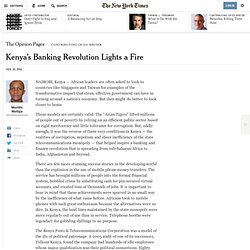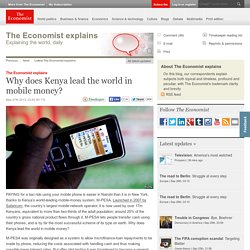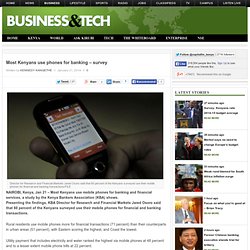

Capture6. Capture5. Capture4. Capture3. Capture2. Capture1. Mobile Banking Survey. M-Pesa and beyond – Why mobile money worked in Kenya and struggles in other markets. This article by Akin Oyebode originally appeared on TechCabal, a VC4Africa publishing partner. “There have been about 200 of these experiments around the world, and maybe only 4 or 5 have been successful.” This was how Michael Joseph, Vodacom’s Director of Mobile Commerce described mobile money to the Financial Times in 2012. When Michael Joseph talks about mobile money, you should listen. Until 2012, he ran Safaricom, the Kenyan company that launched M-Pesa (“pesa’ means money in Swahili).
The quote is a reminder that mobile money remains a hit or miss initiative, and most adopters have struggled to show the type of traction seen in Kenya. Business - More Kenyans using mobile money transfer than banks. By James Anyanzwa Kenya: The use of mobile money in the country has grown sharply in the last five years to overtake banks according to a new study.

According to the latest Fin Access National Survey (2013), more than double the number of adults use mobile phone financial services (11.5 million) compared with banks (5.4 million). Mobile Banking Takes Off in Kenya. Kenya’s Banking Revolution Lights a Fire. Murithi Mutiga NAIROBI, Kenya — African leaders are often asked to look to countries like Singapore and Taiwan for examples of the transformative impact that clean, effective government can have in turning around a nation’s economy.

But they might do better to look closer to home. Those models are certainly valid: The “Asian Tigers” lifted millions of people out of poverty by relying on an efficient public sector based on rigid meritocracy and little tolerance for corruption. But, oddly enough, it was the reverse of these very conditions in Kenya — the realities of corruption, nepotism and sheer inefficiency of the state telecommunications monopoly — that helped inspire a banking and finance revolution that is spreading from sub-Saharan Africa to India, Afghanistan and beyond. There are few more stunning success stories in the developing world than the explosion in the use of mobile phone money transfers. Launched in 2007, there are now 18 million active subscribers to the service. Mobile banking: Is it a phone, is it a bank? Cashless Africa: Kenya’s smash success with mobile money.
Lack of interest?

Sachdev and others now also see other limitations in the M-Pesa model. "There are many benefits to mobile money," said Neal Estey of Boston University's Center for Finance, Law and Policy. "But it should not be sold as a miracle cure for financial inclusion. " He noted that unlike in the U.S., where you may use your smartphone to access your bank account, mobile phones in the developing world are often used instead of bank accounts. For many that means having no opportunity to enjoy the benefits of formal banking: interest-bearing savings products and building a financial record to show creditworthiness.
(Read more: Virtual robbery: Bitcoin theft on the rise) That need not be the case, said Haridas Nair of SAP, the German multinational enterprise software company, which has focused its mobile-money efforts on Asia. "It's possible because a bank is running the service," Nair said. (Read more: Zimbabwe's teen texters explain all) Elsewhere, big bets are being placed. The Economist explains: Why does Kenya lead the world in mobile money? PAYING for a taxi ride using your mobile phone is easier in Nairobi than it is in New York, thanks to Kenya’s world-leading mobile-money system, M-PESA.

Launched in 2007 by Safaricom, the country’s largest mobile-network operator, it is now used by over 17m Kenyans, equivalent to more than two-thirds of the adult population; around 25% of the country’s gross national product flows through it. M-PESA lets people transfer cash using their phones, and is by far the most successful scheme of its type on earth. Mobile banking picking up - survey. MAJORITY of Kenyans use mobile financial and banking platforms because of time saving, 24-hour access and physical security rather than cost benefits, a new mobile banking survey published in Nairobi yesterday established. The joint study by Kenya Bankers Association and Think Business indicates that the increasing use of mobile phone platforms to send and receive money is driven 72 per cent by convenience of less time taken. 69 per cent of the respondents were pushed by the 24-hour accessibility, 68 per cent by physical security with only 57 per cent of Kenyans citing cost saving benefits—an indication of scope for lower transaction costs.
To lower fees on cash transactions, the survey recommends creation of street sub-agents who should charge lower commissions than store-based agents. “Sub-agents would use (for example) normal M-pesa retail outlets to rebalance their cash and M-Pesa stored value,” the report recommends. Mobile banking has a limit - money - business. Last updated 12:26 17/06/2014 Most people are happy to transfer cash with their mobile devices, but draw the line at sums of $50,000 or more, according to Westpac.

The findings come from Westpac's second Mobile Banking Report, based on a survey of 820 of its customers. While 70 per cent were confident using mobile banking to transfer up to $10,000, only 15 per cent were comfortable when dealing with $50,000 or more. Seventy-three per cent used mobile banking to pay bills, up 9 percentage points, and 55 per cent used it to pay friends, up 7 percentage points. Roughly one in four customers were also using their mobile devices to check interest rates or find a branch or ATM. Most Kenyans use phones for banking – survey. Director for Research and Financial Markets Jared Osoro said that 60 percent of the Kenyans surveyed use their mobile phones for financial and banking transactions/FILE NAIROBI, Kenya, Jan 21 – Most Kenyans use mobile phones for banking and financial services, a study by the Kenya Bankers Association (KBA) shows.

Presenting the findings, KBA Director for Research and Financial Markets Jared Osoro said that 60 percent of the Kenyans surveyed use their mobile phones for financial and banking transactions. Rural residents use mobile phones more for financial transactions (71 percent) than their counterparts in urban areas (51 percent), with Eastern scoring the highest, and Coast the lowest. Utility payment that includes electricity and water ranked the highest via mobile phones at 48 percent and to a lesser extent mobile phone bills at 22 percent. However international money transfers are done through Western Union, Money Gram and NationHela. KBA Research Highlights the Interplay between Banks, Mobile Network Operators and Agency Banking. Mobile technology is playing a major role in improving the standards of service delivery in the financial sector, a study by the Kenya Bankers Association shows.

Results from the study show that: Www.kba.co.ke/images/stories/mobile banking/Mobile Banking Survey.pdf. FACTORS INFUENCING MOBILE BANKING IN KENYA: A CASE OF KENYA COMMERCIAL BANK IN GARISSA KORIR GEOFFREY.